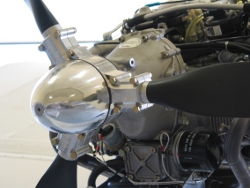
Rotax specifies the following propeller mass moment of inertia limits for their various gearboxes in order to “not overstrain the propeller shaft and gearbox and to avoid problems with the shock absorber installed in the gearbox”:
- Model “A” or “B” gearbox–less than or equal to 3000 kg cm2
- Model “C” gearbox–less than or equal to 6000 kg cm2
So what exactly is “mass moment of inertia”, and what does it mean?
In a nutshell, inertia is defined as the amount of resistance to a change in motion. The more resistant an object is to changes in motion (whether that is slowing down or speeding up), the greater its inertia. One example is that a heavy book is harder to get sliding than a lightweight book (ignoring friction effects). The heavy book has more resistance to changes in motion, so it has more inertia.
The definition of inertia is based on Newton’s First Law: objects in motion tend to stay in motion and objects at rest tend to stay at rest. Imagine a book sitting on a table. The book will not slide across the table unless something pushes it. Another example is the feeling of being pushed back into your seat when your car accelerates. Your body tends to stay at rest and the car moves forward. The difference you feel is the seat pressing into your back.
Specifically, engine manufacturers are concerned with the rotational mass moment of inertia of the propeller. Rotational mass moment of inertia is defined as the sum of the product of mass times radius squared, where the radius is the distance of the mass from the axis of rotation.
For a propeller, the mass in this definition includes the mass of the propeller hub and the propeller blades. Notice that the units on Rotax’s limits match the definition [kg (mass) * cm2 (radius, or distance, squared)]. Rotational mass moment of inertia can be thought of as the amount of resistance to changes in rotational speed. Here are a few everyday examples of rotational mass moment of inertia:
- It is easier to get a merry-go-round turning when children are at the platform’s edges than when the same merry-go-round has adults at its edges. The one with the adults on it has the higher rotational mass moment of inertia because it has greater mass.
- A person sitting in an office desk chair is easier to spin with her arms tucked in than when she has her arms extended. Because the distance of mass (her arms) from the axis of rotation is greater with her arms extended, she is more resistant to being spun or stopped, and she has more rotational inertia in this position.
Notice that rotational inertia is not only determined by mass, but also the distance of the mass from the axis of rotation (also called the moment).
Every object has a unique equation for calculating mass moments of inertia. The more complex the geometry, the more complex the equation gets. Just like the merry-go-round and office chair, the rotational mass moment of inertia of a propeller is directly related to its geometry, the amount of mass and its distance from the axis of rotation. Every time a cylinder fires in your engine, it exerts a rotational force on the shaft and accelerates the propeller. The rotational inertia of the propeller causes it to resist the acceleration, putting torsional loads on the gears and shafting. The higher the mass moment of inertia, the higher the loads. These loads are transmitted through the gearbox, engine, and airframe thousands of times per minute in a typical light aircraft setup. Unless the loads are reduced or dissipated, the associated vibration can cause instrument failure, engine and airframe damage.
Engines and gearboxes are designed to carry specific loads. Engine and gearbox manufacturers specify mass moment of inertia limits so these design loads are not exceeded. Exceeding the mass moment of inertia limit can put your powerplant and airframe at risk for rapid or excessive wear or even failure.
It’s easy to go to AirVenture and pick up a snazzy new composite prop or to want to get that same 3-bladed big prop your buddy raves about. But whenever purchasing a new propeller, it is always a good idea to contact the manufacturer to be sure the prop does not exceed the mass moment of inertia limitations of your engine and gearbox combination. You could be saving yourself a lot of headaches or even avoiding a premature engine failure.
If this article was helpful to you or for more information on this or other topics, please contact us.
